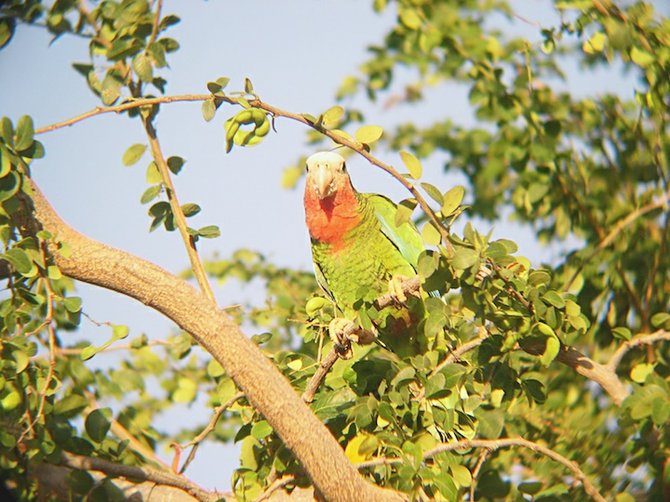THE latest surveys of the Bahama Parrot on Inagua indicate that the population is on the rise, reaching an estimated 14,000 birds.
The surveys, conducted by Dr Frank Riviera of the US Fish and Wildlife Service and Zeko McKenzie, lecturer at College of the Bahamas, come five years after the parrot population on that island was decimated by Hurricane Ike.
“In my view, the parrot population on Inagua is at the highest estimated level since 2003,” said Dr Riviera in his report to the Bahamas National Trust (BNT).
The BNT undertook long-term monitoring of the Bahama Parrot on Inagua, with the assistance of Dr Riviera and Caroline Stahala, that will last 10 years.
Recently, Mr McKenzie was added to the parrot project by the BNT, which in conjunction with the Nature Conservancy (TNC) helped secure private funding for McKenzie to obtain his bachelor’s degree in biology with a focus in ecology.
Mr McKenzie now has his master’s degree and is a lecturer at COB, but was very excited to work on this project with the BNT.
“I was able to travel to Inagua, where I’ve never been, and work with the parrots, which I’ve never done,” said Mr McKenzie. “The project was a great experience for me, and I was able to increase my field experience, and gain valuable knowledge working with Dr Riviera on this Bahama Parrot research.”
The last parrot population census was conducted in 2002-3 on both Inagua and Abaco by the BNT.
The census showed that there were more parrots in Inagua than Abaco, with 8,000 – 12,000 birds in Inagua, and 2,500 in Abaco.
This information was the basis of further research, and was beneficial in monitoring the parrot populations in the Bahamas.
Monitoring of the Bahama Parrot on Abaco after Hurricane Jean showed that it took 1-2 years before the parrots would begin to reproduce normally.
In a survey conducted in March 2009, the Inagua population was estimated at 5,000 parrots. In 2010, two years after Hurricane Ike, the population had increased to 7,000 birds, still below the 2003 census.
The Bahama Parrot was once found on seven islands, but now can only be found on Abaco and Inagua.
The breeding strategies in the two parrot populations are different.
The Abaco population is unique because it is the only ground-nesting parrot in the Western Hemisphere; it is also the only parrot in the world that has adapted to fire.
The breeding area of the parrot in Abaco is protected in the Abaco National Park, which was created in 1994. One of the threats to the ground nesting Abaco parrots is predation by feral cats.
The BNT has been conducting a predator control programme in the breeding area of the Abaco National Park for the past four years; as a result there has been a significant decline in predation.
The Bahama Parrot is protected by the Wild Birds Protection Act and anyone caught harming or capturing a parrot can face a significant fine and/or imprisonment.
“The recent population census of the Bahama Parrot on Inagua is certainly good news,” said Lynn Gape, BNT deputy executive director. “This combined with the recent census of the Abaco Parrot population showing a population increase from 2,500 to 4,000 gives us hope that with continued management efforts we can continue to have healthy and viable endemic parrot populations on Abaco and Inagua.”





Comments
pablojay 9 years, 9 months ago
This is good news, the increased population,but for general knowledge and good reporting , this article should have at least mentioned the names of the other five islands that used to have parrots because i do not know them.
mattcoleman 8 years, 11 months ago
http://www.bartendertrainingsource.com/">bartender training source guide is the best
Sign in to comment
Or login with:
OpenID